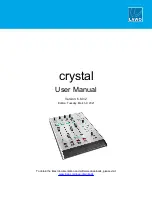
10
NOWPAK LINER-BASED CANISTER SYSTEM
User Manual | Entegris, Inc.
MOVING THE CANISTERS
Due to the size and volume of the 40- to 200-liter
canister, it is recommended that a four-wheel drum
dolly be used to move the filled containers. Other
methods may be suitable but should be tested on a
container filled with water before being used on a
canister that contains chemical.
WARNING: Never roll a filled canister on the
chime edge or on its side! Canisters must not be
dropped. These actions could cause the canister
to crack or suffer other structural failure.
WARNING: Larger canisters, such as 40- to 200-liter,
are very heavy and should only be moved by
trained personnel using properly rated moving
equipment. Improperly lifting or moving canisters
can cause damage, including breakage of the
canister or serious injury.
WARNING: Under no circumstances should
a filled canister be transported without the
mechanical aids described above.
STORING AND STAGING THE CANISTERS
Canisters filled with chemical must be stored under
proper conditions, as determined by the type of
chemicals involved. At the end use site, filled
canisters must be staged before being used to
dispense chemical, as required by the type and
amount of chemical used.
Storing Filled Canisters
Storage conditions vary by chemical contained in the
canister. Contact the chemical supplier for appropriate
storage for each chemical.
Staging Filled Canisters
The time required for the chemical in a canister to reach
thermal equilibrium is determined by the properties of
the contained chemical and the staging conditions.
Please contact the chemical supplier for appropriate
staging times for each chemical.
SECTION 6: REFURBISHING AND FILLING THE CANISTERS
—
The procedures in this section of the guide are
performed by chemical suppliers when an empty
canister is received from an end user and when
filling a refurbished or new liner-based canister.
Refurbishing and filling a liner-based canister consists
of the following procedures:
• Empty canister disassembly and liner removal
• Inserting a liner into the canister
• Inflating a liner using a bag inflation fixture (BIF)
• Inflating a liner using a manual inflation fixture
• Filling a canister with chemical and inserting
the diptube
• Capping the canister
• Shipping the canister
IMPORTANT: The chemical supplier must ensure the
correct components are used for each canister refurbished.
See Appendix B: Canister Compatibility Matrix, page 32,
to find the liners, diptubes, adapters, and closures to
be used with each canister.
EMPTY CANISTER DISASSEMBLY AND LINER REMOVAL
Use this procedure to remove the diptube and liner
from an empty canister and dispose of the liner
properly. This is typically the first process performed
on a canister that has been received for refurbishing.
Items needed:
• Liner disposal plug: part number NA-07
(for 40- to 200-liter canisters); part number
DA-03 (for 200-liter canister).
• Appropriate handling supplies for the used liner
and diptube. Some chemical will remain on these
when they are removed from the canister. Entegris
recommends placing the used diptube into a
sealable bag.











































